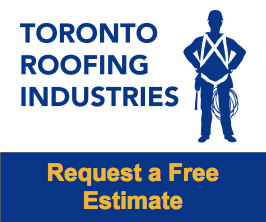Built-up Roofs (BURs, or Tar & Gravel)
Built-up Roofs typically consist of 4 plies (or layers) of felts, mats or fabrics, adhered with hot tar that is mopped over 100% of the underlying surface. In Ontario, the surfacing material is most commonly comprised of gravel embedded in a final flood coat of tar. Alternately, mineral surfaced granular cap sheets can be used which provide an extra layer of waterproofing material, and optional reflective coatings for increased energy efficiency.
Built-up roofs have been in use since the 1880’s, and with advancements in material technology, they remain an effective and viable roofing system. Their success is due to the redundancy of 4 layers of waterproofing membranes, and damage protection provided by a gravel surface.
BUR’s can be readily maintained over their life-cycle, however, the delivery of hot tar to the repair location involves increased time and set-up costs when compared with repairs to other roofing systems.
2 ply SBS Modified Bitumen
2-ply SBS modified bitumen roofing systems offer many advantages over other roofing systems.
- They are proven. Polymer modified bitumen roofing systems have been used in North America since 1975 and have stood the test of time. They are the most commonly installed flat system in residential re-roofing applications, and there is a well established labour pool of skilled tradesmen that are qualified to install these systems.
- They have superior physical properties compared to other multi-ply roofing systems. SBS modified bitumen systems outperform tar and gravel, and APP modified bitumen systems in tensile strength, flexibility at cold temperatures, and fatigue resistance (the number of times a material can be flexed before it fails). SBS modified bitumen is a rugged material that performs extremely well in the Canadian climate with hot and cold temperature extremes and expansion and contraction cycles from daily heating and cooling.
- Granulated cap membrane options offer a wide range of colours, resistance to wear from foot traffic, and solar reflective properties.
- They are cost effective. There are several manufacturers of high performance SBS modified bitumen materials in a highly competitive marketplace. This ensures commodity type pricing and continual advancements in technology to provide state-of-the art roofing systems at affordable prices.
- They are maintainable over the life of the roof. A 2-ply system can be reliably and cost effectively repaired to extend its life, thereby deferring the cost of re-roofing and decreasing the cost of ownership per year of roof life.
EPDM
Ethylene Propylene Diene Monomer (EPDM) is a single-ply synthetic rubber membrane with a proven track record of use since the early 1960’s. It’s primary performance benefit comes from the materials resistance to UV radiation. EPDM membranes are available that carry up to 30 year manufacturers’ warranties.
Enhancements in material technology have addressed EPDM’s early problems of low tear strength, poor puncture resistance, and installation difficulties at the seams. The material is delivered in roll widths ranging from xx to 30 ft. Seams are adhered, and products with a factory applied tape of uncured EPDM material are quick to install and result in strong seams that are free of defects. Re-enforced and fleece-backed membranes are available to provide puncture resistance and increased tear strength.
Membranes are available with white solar reflective surfaces to reduce solar heat gain and increase energy efficiency.
EPDM systems can be adhered to the underlying surface, mechanically fastened, or loose-laid and ballasted with river rock or pavers to provide wind uplift resistance. EPDM membranes are all cold applied, eliminating the potential safety risks associated with open flame installation methods.
TPO
Thermoplastic poly-olefin (TPO) roofing membranes were introduced in North America in 1987 and began widespread use in the early 1990’s.
Thermoplastics are a category of material that can be heated, cooled, and reheated without changing their physical characteristics. Poly-olefins are added to increase chemical durability, lifetime, and other physical characteristics of the membrane. The ASTM standards for TPO’s are loosely defined, leaving much room for technological innovation from material manufacturers. As with most roofing materials, end users are wise to consider the differences in quality between membrane suppliers.
A TPO sheet is manufactured with a bottom layer, a middle scrim (fabric) layer that provides strength, puncture resistance and tear resistance, and a top layer that gives the sheet it’s protection from the elements. An important specification to be considered in choosing a TPO material is thickness above scrim, as products with a thicker top layer will general provide a longer life.
TPO membranes are delivered in roll of widths from xx to xx ft, and in thicknesses of 40 or 60 mils. They can be adhered, mechanically fastened, or loose laid with ballast. Seams are heat welded, with seam strength of 3 to 4 times that of EPDM membranes, providing high resistance to wind uplift. TPO products carry up to 20 year manufacturers’ warranties, and are available with puncture and hail resistance warranties.
TPO products are also available in a wide range of colours, some with highly reflective coatings that reduce solar heat gain and increase energy efficiency.

